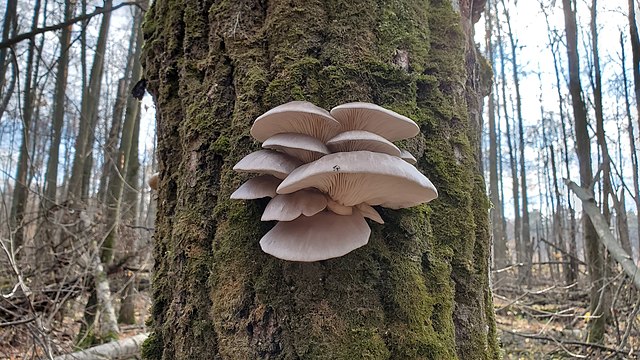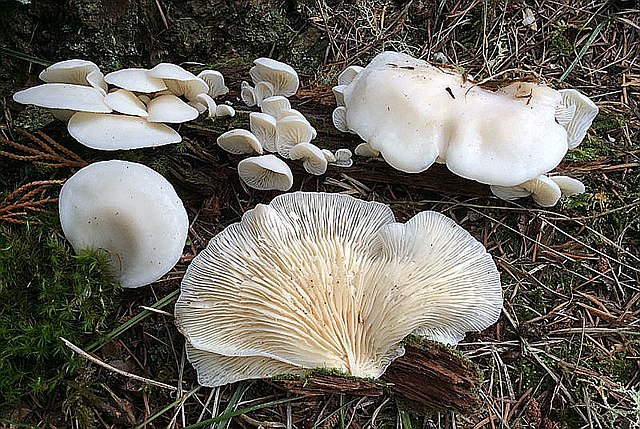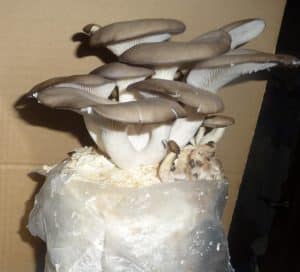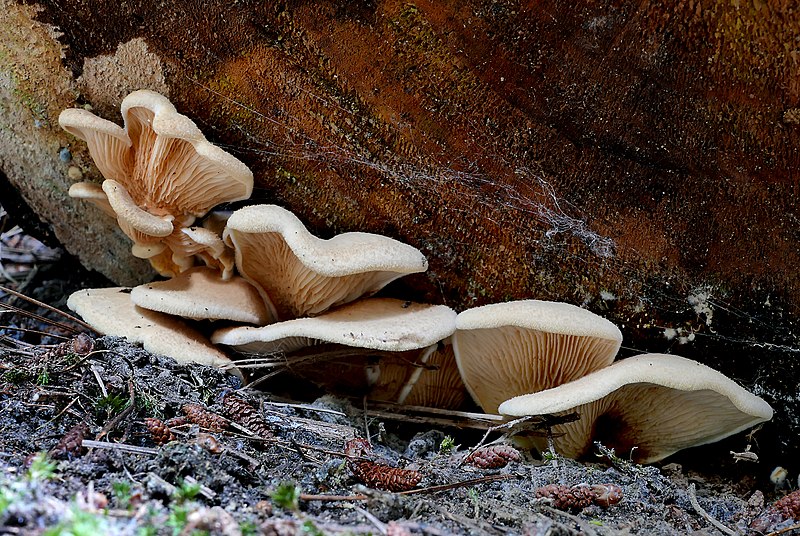
If you’re looking for a beginner-friendly mushroom with a lot of culinary versatility, try the oyster mushroom! The best-known oyster mushroom is Pleurotus ostreatus; while it is found widely in temperate and subtropical forests, it may also occur in the same habitats as the summer oyster (Pleurotus pulmonarius) and aspen oyster (Pleurotus populinus). All three are found on hardwood trees, and P. populinus is restricted specifically to aspens and poplars; P. pulmonarius reportedly grows on conifers in western North America.
Identification
The white to light gray cap with white or cream gills sometimes resembles a raw oyster, hence the common name. They also often have a faint aroma similar to licorice. Their gills extend partway down the stipe (stem), rather than stopping where the cap meets the stipe.
Oyster mushrooms grow exclusively on rotting wood in the wild, breaking down the lignin within. They’re often found in clusters sprouting out of a standing tree or fallen log. While fall is a popular time to look for oysters, they may also fruit in spring and summer (especially P. pulmonarius), making them a more likely find than fungi with a more limited fruiting window. If you’ve noticed a tree with oyster mushrooms in one season, make sure you check at other times of the year, too.
However, you’ll want to keep your eyes peeled for lookalikes–do you think these mushrooms are oysters?

Lookalikes
One of the most common lookalikes is the angel wing mushroom (Pleurocybella porrigens), shown in the photo above. While it looks similar, it is not as robust as oysters, and prefers to grow on conifers. For a long time it was considered safe to eat; however, fatal poisonings of over a dozen people occurred in 2004, with another fatality in 2009. The victims were all older and many had pre-existing liver conditions, but these incidents still necessitate caution.
Phyllotopsis nidulans and Phyllotopsis subnidulans also look superficially similar to Pleurotus species. However, these have a more disagreeable odor that would probably prevent anyone from eating them in the first place. Hohenbuehelia petaloides looks similar in color and texture, but grows on soil rather than decaying wood.
Cooking With Oysters
These mushrooms lend themselves to a variety of recipes, from pasta and eggs, to soups and sautees. They have a mild, pleasant flavor, and will readily absorb flavors from sauces, cooking oils, and other ingredients. Because of their versatility they can stand in for other types of mushrooms in many recipes, including those featuring the white button mushrooms commonly sold at grocery stores.
When fresh they are quite firm, though if left in the fridge too long they start to go soft. The best way to preserve them is to sautee them in butter or olive oil, then freeze. They can be dehydrated, though this can affect the texture once rehydrated; the same goes for canning.
Cultivating Oyster Mushrooms

Oyster mushrooms are one of the easiest mushrooms to cultivate. Many people start with a small oyster-growing kit that can be easily cultivated indoors. Companies that create these kits often have spawn available if you want to put together your own, larger growing setup. There are several “colors” (species) of oyster mushroom available, like blue, yellow, and pink; I like blue as a good starter mushroom.
While you can inoculate a log with spawn, an easier route is to get a couple of bags of hardwood stove pellets, preferably in plastic bags; they have the advantage of having been essentially sterilized when they were dried with heat, minimizing the chance of contamination by other fungi. Soak the pellets in a large tub of water until they fall apart into sawdust. Drain but keep them damp, then add ten parts sawdust to one part oyster mushroom spawn to one of the empty bags. I also like to throw in one part dry chicken feed as well for additional nutrients. You will probably have more sawdust than can fit in the original pellet bags; feed sacks make good additional growing bags.
Tie the bags shut, then poke holes with a knife or icepick all around each of the bags so the mushrooms have something to grow out of. Store the bags somewhere where they won’t dry out or get too hot or cold (I just keep mine outside since the climate is mild here.) Then just keep an eye on them until you start noticing mushrooms popping out of the holes. This could take a few weeks to a few months depending on the conditions the bags are kept in.
Conclusion
Oyster mushrooms, when properly identified, can be a marvelous opportunity to experiment with cooking, preserving, and even growing wild mushrooms. As with any mushroom, make sure you try a small amount, properly prepared, if this is your first time consuming it, just in case you have a bad reaction.

—————
Written by Rebecca Lexa
Rebecca Lexa is a certified Master Naturalist in the Pacific Northwest. She teaches classes on foraging and other natural history topics, both online and off. More about her work can be found at http://www.rebeccalexa.com.
Many of our readers find that subscribing to Eat The Planet is the best way to make sure they don't miss any of our valuable information about wild edibles.
See our privacy policy for more information about ads on this site






